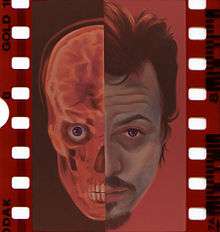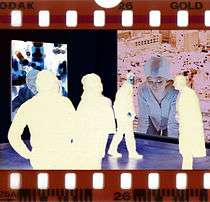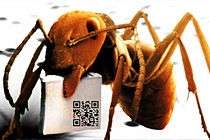Fabrice de Nola
| Fabrice de Nola | |
|---|---|
 Fabrice de Nola, Self-portrait in negative, 1999 (oil on canvas, reproduction on negative film). | |
| Born |
1964 Messina, Italy |
| Nationality | Italian-Belgian |
| Known for | Conceptual art, painting, photography |
Fabrice de Nola is an Italian-Belgian artist born in Messina (Sicily) in 1964. He introduced the use of QR codes in oil paintings. In 2006, he created the first oil paintings containing texts and web connections to be used on mobile phones.[1][2]
Biography
The son of an Italian mother and a Belgian father, Fabrice de Nola lived in Messina until 1981. He attended the Art school in Palermo, but left after one year in order to pursue his interest in photography. At the end of the 1980s he moved to Milan, and thereafter to Mechelen, his father’s hometown.[3]
In the mid-1980s he worked as a scene-painter in Geneva, Cairo and Rome.[3] In those early years, he used photocopiers and photography as techniques in support of his painting. In the mid-1990s, the computer[4] became an essential tool for the preparation and pre-production of his paintings.[5]
In 1996, he showed at the Il Ponte Contemporanea Gallery in Rome where he remained until the year 2000.[6]

In 1997, Fabio Sargentini invited Fabrice de Nola to the Palermo exhibition Giro d’Italia dell’Arte curated by Demetrio Paparoni, a survey of young Italian artists, at the l’Attico Gallery.[7] That same year he participated in Roma, 4 young painters, which showed four Roman painters and was curated by Fabio Sargentini at the Generous Miracles Gallery in New York.
In 1999, during the 48th Biennal of Venice, he exhibited in Authoritratti italiani at the Fondazione Bevilacqua La Masa. Posters were put up at that time in Venice reproducing his works. De Nola painted a self-portrait using photographs, CT and X-rays: painted on one half is his face, while on the other half the interior is visible, showing skull, muscles, eyeball and brain.
In 2000, he took part in two group shows in Rome: Lungo il muro del Gasometro at the Teatro India Gallery and Giganti at the Imperial Forum of Nerva. He also showed that year in Sui generis at the PAC in Milan.
In 2001, he created a work on the building site of the Auditorium of Rome. The painting was commissioned by the Ministry of Culture[8] for the permanent collection of MACRO.[9] That same year he participated in the Le Muse inquietanti at the Pascali Museum in Bari and Dalla Mini al mini at the Palazzo delle Esposizioni in Rome.
In 2003, de Nola showed his Neural Pro project in a one-man show at Palazzo Isnello at Il Genio of Palermo. In Rome he exhibited the series Air Ocean at the Teatro Umberto and two large canvases from the Cerasi Collection at the Cloister of Bramante. The Italian Ministry of Foreign Affairs invited him to the Futuro italiano exhibition[10] at the European Parliament in Brussels.

In 2006, he created the first oil painting using painted QR code.[1][2] The work has been exhibited the same year in Milan.[11] In 2007, the Ministry of Foreign Affairs commissioned two works from him for the Farnesina Experimenta Art Collection.
In 2008, he participated in the VII International Festival of Photography of Rome with his show Skip Life,[12] and he was also invited to the 15th Rome Quadriennale where he presented an advertising installation for the fake Neural Pro Company.[13]
Projects and works
- In 1997, inspired by Andrei Rublev, he painted a negative image, which he photographed in order to see its positive effect on film. The following year he exhibited part of the project Inverse[14] at the Galleria Il Ponte Contemporanea of Rome. The works are diptychs composed of a negative oil painting and the positive of its photographic reproduction. In 2007, the MLAC (Contemporary Art Lab Museum)[15] of the Sapienza University of Rome showed his first large painting of the Inverse cycle.[14]
- In 1999, he started the ecological project Oceano Aria and the project Antennaria on digital identities. Antennaria was inspired by the Echelon affair and, in 2000, the Il Ponte Contemporanea Gallery of Rome showed some works at the solo show Backdoors.
- Since 2003 he has been working on the Neural Pro project, which simulates the existence of a data-processing and biotechnological multinational whose products integrate with the human body creating a man-machine interface without external body devices. He held two conferences on this subject in 2008: Prospects of Web Evolution at Palazzo delle Esposizioni during the XV Quadriennale, and Mind-Machine Symbiosis,[16][17] at the Faculty of Sociology of the Sapienza University of Rome. The idea was presented at the Google competition Project 10100 (10 to the 100th) with the name of HI (Human Interface).[18]
-Detail_02.jpg)
- In 2006, he initiated the Active project, in order to make painted works communicate with mobile phones. The project,[2] in the spirit of the Internet of Things, makes use of QR codes painted in oil or embedded in photos, containing texts and mobile web links.[19]
See also
References
Bibliography
- Marco De Logu (curated by). Vedere la normalità. VII FotoGrafia Festival di Roma. Rome, Zonettive Edizioni, 2008. ISBN 88-89303-07-7.
- Lorenzo Canova, Chiara Bertola, Bruno Corà, Daniela Lancioni, Claudio Spadoni. XV Quadriennale di Roma. Venezia, Marsilio Editori, 2008. ISBN 88-317-9532-5.
- Maurizio Calvesi, Lorenzo Canova, Marisa Vescovo, Marco Meneguzzo. Collezione Farnesina Experimenta. Rome, Gangemi Editore, 2008. ISBN 88-492-1486-3.
- Lorenzo Canova. Visione romana, percorsi incrociati nell'arte del novecento. Pisa, Edizioni ETS, 2008. ISBN 978-88-467-2086-3.
- Giuseppe Cerasa (curated by). Donne di Roma. Rome, Fondazione Musica per Roma/Nero Editore, 2009.
- Francesco Gallo. Palermo/Babilon/Palermo. Sofia, Edizioni Casa Sicilia Bulgaria, 2009.
- Lorenzo Canova. Una mano per l'AIL. Milano, Christie's. 2009.
- Graziano Menolascina. Occhio Magico. Rassegna internazionale di fotografia. Rome, Edizioni Istituto Portoghese Sant'Antonio. 2009.
Notes
- 1 2 Fabrice de Nola at the Palazzo Riso.URL retrieved 29 January 2011.
- 1 2 3 Active Project at official Fabrice de Nola website.URL retrieved 20 june 2009
- 1 2 Artist's biography in Italian, at «denola.com». URL retrieved 20 june 2009.
- ↑ Gianluca Marziani, Dipingere al computer, «Flash Art Italia», Milan, october 1999, issue 288.
- ↑ Gianluca Marziani. NQC, Arte italiana e tecnologie: il nuovo quadro contemporaneo. Rome, Castelvecchi Editore, 1998. ISBN 88-8210-074-X.
- ↑ Achille Bonito Oliva. The Bridges of Art. Milano, Genève, Skira, 2004. ISBN 88-8491-810-3.
- ↑ Giro d’Italia dell’Arte at L'Attico Gallery website. URL retrieved 20 june 2009.
- ↑ Purchases and Gifts in Rome Museums (1997-2005). Retrieved 5 December 2009.
- ↑ Arnaldo Romani Brizzi, Ludovico Pratesi. Roman Construction Sites. Rome, Gangemi Editore, 2001. ISBN 88-492-0151-6.
- ↑ Futuro italiano. Exhibition's official website. Retrieved 5 december 2009.
- ↑ Bottom up, news about the show. Retrieved 21 January 2011.
- ↑ Skip Life. Special cases of normality in day-to-day life page on FotoGrafia Festival website. Retrieved 5 december 2009.
- ↑ Paolo Conti. I visitatori decidono il titolo «Corriere della Sera», page 53, 13 june 2008. Retrieved 5 december 2009.
- 1 2 (Italian) Inverse at «denola.com». URL retrieved 21 june 2009
- ↑ (Italian) Paesaggi metropolitani page at the MLAC (Contemporary Art Lab Museum) of the Sapienza University of Rome. URL consultée le 21 juin 2009.
- ↑ Simbiosi mente-macchina, conference text at Fabrice de Nola website. URL retrieved 21 june 2009.
- ↑ Simbiosi Mente Macchina, conference text (pdf) at Sapienza University website. URL retrieved 21 june 2009.
- ↑ HI. Human Interface Foundation Project 8 november 2008. Retrieved 21 june 2009.
- ↑ Active at Flickr Retrieved 11 July 2010.
Sources
.
External links
| Wikimedia Commons has media related to Fabrice de Nola. |
- (Italian) denola.com Official Fabrice de Nola Website URL retrieved 20 June 2009.
- Fabrice de Nola on Flickr URL retrieved 21 January 2011.
- Fabrice de Nola on Twitter URL retrieved 20 January 2010.
- Fabrice de Nola at the Palazzo Riso URL retrieved 29 January 2011.
- Evolving Time. Official Fabrice de Nola Blog URL retrieved 20 June 2009.
- Skip Life. Special cases of normality in day-to-day life FotoGrafia International Rome's Festival 2008. URL retrieved 20 January 2010.